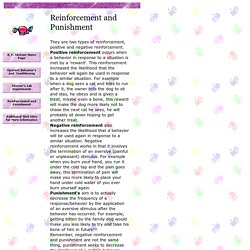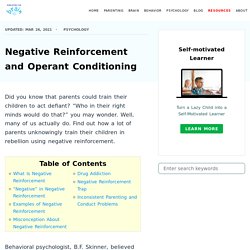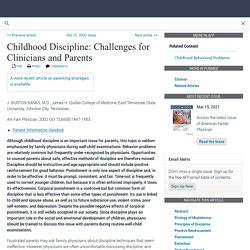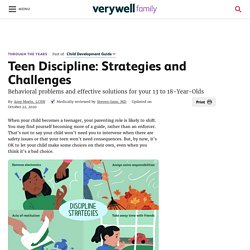

Using Reinforcement and Punishment at Home. Reinforcement and Punishment. They are two types of reinforcement, positive and negative reinforcement.Positive reinforcement occurs when a behavior in response to a situation is met by a 'reward'.

This reinforcement increased the likelihood that the behavior will again be used in response to a similar situation. For example when a dog sees a cat and tries to run after it, the owner tells the dog to sit and stay, he obeys and is given a treat, maybe even a bone, this reward will make the dog more likely not to chase the next cat he sees, he will probably sit down hoping to get another treat.Negative reinforcement also increases the likelihood that a behavior will be used again in response to a similar situation.
The Difference between Positive/Negative Reinforcement and Positive/Negative Punishment. February 5, 2013 7:40 pm Published by Kelley Prince M.A., BCBA In Applied Behavior Analysis, there are two types of reinforcement and punishment: positive and negative.

It can be difficult to distinguish between the four of these. Therefore, the purpose of this blog is to explain the differences in order to help parents and professionals develop appropriate interventions to improve behavior. Reinforcement. Positive Reinforcement and Examples - Psychology. Positive reinforcement is a preferred disciplinary strategy in positive parenting because this method doesn’t involve aversive measures or punishment.

However, this method doesn’t always work the way we think. Let’s find out what positive reinforcement is, its applications in everyday life and the best way to use it. What Is Positive Reinforcement? In operant conditioning, positive reinforcement aims to increase desired behavior by adding a favorable stimulus right after that behavior occurs. Negative Reinforcement and Operant Conditioning. Did you know that parents could train their children to act defiant?

“Who in their right minds would do that?” You may wonder. Well, many of us actually do. Find out how a lot of parents unknowingly train their children in rebellion using negative reinforcement. Positive Reinforcement (giving) Negative Reinforcement (removing) Positive Punishment in Operant Conditioning [Definition & Examples] Positive punishment is often used in life when we want to suppress unwanted behavior.
![Positive Punishment in Operant Conditioning [Definition & Examples]](http://cdn.pearltrees.com/s/pic/th/punishment-conditioning-239609851)
Let’s examine its definition, usage and examples, especially when it comes to parenting. What is Positive Punishment Positive punishment is a type of operant conditioning, a theory proposed by psychologist B.F Skinner. Its main purpose is to reduce the likelihood of an undesired behavior repeating in the future by applying an aversive stimulus after the behavior occurs. What is Negative Punishment (Examples and Effectiveness) In this article, we will review negative punishment, its definition, examples, and drawbacks.

American psychologist B.F. Skinner developed the theory of operant conditioning, which stated that a person or animal’s behavior could be increased or decreased by adding or removing appropriate stimuli after the behavior is exhibited. The difference between classical conditioning and operant conditioning is that classical affects unconscious behavior, while operant affects conscious behavior. Negative Punishment (withdraw) Positive Punishment (applying)
Childhood Discipline: Challenges for Clinicians and Parents. Although childhood discipline is an important issue for parents, this topic is seldom emphasized by family physicians during well-child examinations.

Behavior problems are relatively common but frequently under-recognized by physicians. Opportunities to counsel parents about safe, effective methods of discipline are therefore missed. Discipline should be instructive and age-appropriate and should include positive reinforcement for good behavior. Punishment is only one aspect of discipline and, in order to be effective, it must be prompt, consistent, and fair. Discipline strategies for teenagers. Teenage discipline: the basics Discipline isn’t about punishment.

It’s about teaching children appropriate ways to behave. For teenagers, discipline is about agreeing on and setting appropriate limits and helping them behave within those limits. Discipline for Teens: Strategies and Challenges. When your child becomes a teenager, your parenting role is likely to shift.

You may find yourself becoming more of a guide, rather than an enforcer. That’s not to say your child won’t need you to intervene when there are safety issues or that your teen won’t need consequences. But, by now, it’s OK to let your child make some choices on their own, even when you think it’s a bad choice. How to Reward Your Teen for Good Behavior. Teenagers are young adults who are trying to learn the ways of the world.

When they do something great at school or at home or simply make a healthy decision, parents can give them a reward. The reward does not have to be money, but it is a nice way to say "thank you" or "I'm proud of you. " Parenting A Teen Through Positive Reinforcement - Back On Track. Most parents can agree: the teenage years can be rough! Hormones are raging, they are trying to gain more independence, and they spend a lot of time away from their parents and their home while hanging with friends. One minute they love and adore you, the next minute you ruined their life. Can many of you relate? When tempers flare and disagreements are happening, it’s hard to not resort to yelling and harsh discipline, but studies are showing us that positive reinforcement may be the key to success, not just in the home but also in their school life.
Operant Conditioning (B.F. Skinner) How Reinforcement and Punishment Modify Behavior Operant conditioning, also known as instrumental conditioning, is a method of learning normally attributed to B.F. Skinner, where the consequences of a response determine the probability of it being repeated. Through operant conditioning behavior which is reinforced (rewarded) will likely be repeated, and behavior which is punished will occur less frequently. Operant Conditioning. Basic Principles of Operant Conditioning: Thorndike’s Law of Effect Thorndike’s law of effect states that behaviors are modified by their positive or negative consequences. Learning Objectives. Edward Thorndike - Law of Effect. By Dr. Saul McLeod updated 2018 The law of effect principle developed by Edward Thorndike suggested that: